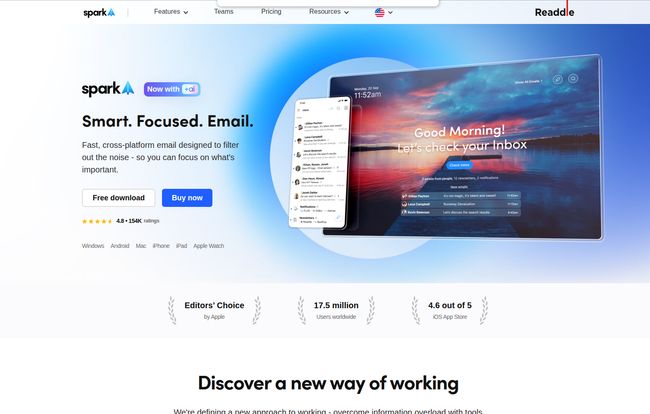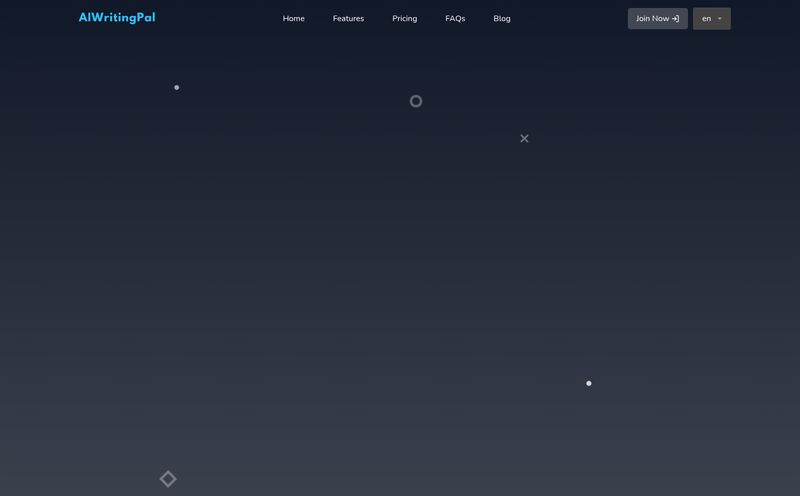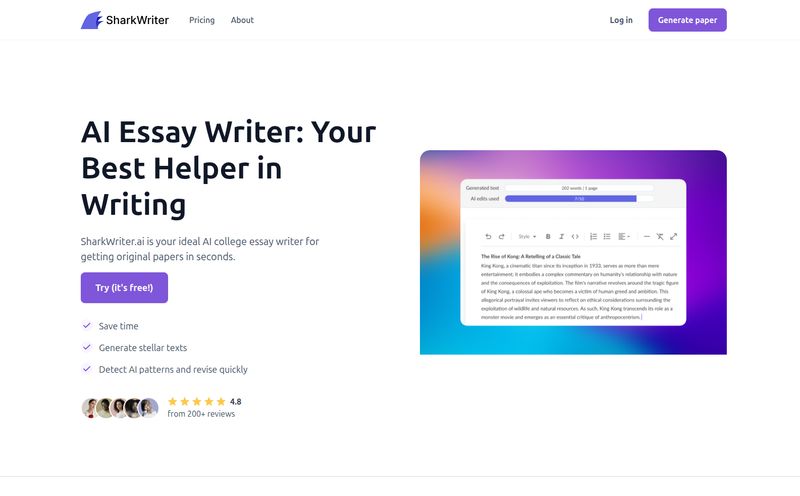It’s the digital equivalent of a room that you can never, ever get completely clean. You spend an hour sorting, deleting, and replying, only to turn around and find a fresh layer of dust—I mean, a fresh batch of newsletters, notifications, and “just circling back” messages. For years, I've felt like I'm losing the war against my own inbox. It’s a constant drag on my focus and, honestly, my sanity.
So, whenever a new tool comes along promising to be the magic bullet, my inner SEO-and-productivity-nerd gets a little tingle of excitement. That’s what happened when I decided to give Spark Mail a serious try. It's been on the scene for a while, backed by the solid team at Readdle, but with its recent injection of AI features, it’s making some big promises. But are they promises it can keep? Let's get into it.

Visit Spark Mail
So, What is Spark Mail, Really?
First off, Spark isn’t just another pretty face on your phone or desktop. It’s not simply a container for your Gmail or Outlook account. It’s an opinionated piece of software. It has a philosophy: your inbox should work for you, not the other way around. Its whole design is built around the idea of reducing noise, surfacing what's actually important, and giving you back your time. A noble goal, right?
It pulls all your email accounts—iCloud, Google, Yahoo, Exchange, you name it—into one central hub. But instead of just listing everything chronologically like a traditional client, it immediately starts sorting, filtering, and well, getting smart.
The Features That Genuinely Make a Difference
I’ve tested more productivity apps than I can count, and most of them are packed with features that look great on a marketing page but fall flat in daily use. Spark, for the most part, avoids this trap. The tools feel intentional.
The Smart Inbox: Your Digital Bouncer
This is the core of the Spark experience. Instead of one monstrous feed, your emails are automatically grouped into categories like People, Notifications, and Newsletters. It's like having a bouncer at the door of your inbox who directs casuals to the general area and ushers your VIPs straight to their table. Emails from actual human beings sit right at the top, waiting for you. The promotional stuff and automated updates? They're bundled neatly below. It’s a simple change, but the psychological effect is huge. The anxiety of seeing “50 unread emails” vanishes when you realize only three of them are from actual people needing a reply.
Meet Your AI Ghostwriter
Okay, here’s the shiny new toy: Spark +AI. I was skeptical. I’ve always believed that relying too much on AI can strip the personality from your communication. And sometimes, it does. But for the mundane stuff? It’s a lifesaver.
The AI can help you compose quick replies, rephrase a sentence to sound more (or less) formal, or even write an entire email from a short prompt. My favorite use case is the AI Summary. You know those nightmare email threads with ten people chiming in? Spark can read through the whole mess and give you the cliff notes. It's not perfect, but it's saved me from rereading a novel’s worth of back-and-forth more than once.
Gatekeeper: Finally, Peace and Quiet
This might be my favorite feature, and it’s so brilliantly simple. When you get an email from a new sender, someone you've never interacted with before, Spark doesn’t just let it into your inbox. It holds it at a virtual gate. You get a notification at the top of your screen asking if you want to Accept or Block emails from this sender. It's the digital equivalent of looking through the peephole before opening your door. One click and you can banish a persistent spammer or annoying PR pitch forever. chef's kiss
Tools for the Modern Workflow
Beyond the big three, Spark has a suite of smaller tools that just make sense. You can Snooze an email to have it reappear at a more convenient time. You can schedule emails to Send Later, which is perfect for not looking like a maniac who works at 2 AM. You can also mute entire conversations that you’re looped into but don't need to follow, sending them straight to your archive without bothering you with notifications.
And for those who work in teams, there are collaboration features baked right in. You can have a private chat with a colleague in the sidebar of an email thread, draft an email together in real-time, and share inboxes for things like `[email protected]`. It turns email from a solo activity into a team sport.
My Honest Take on Using Spark
Look, no tool is perfect. After using Spark as my primary email client across my Mac, iPhone, and even a Windows machine for a bit, I've found things to love, and a few things that make me go “hmm.” The cross-platform experience is fantastic; everything syncs beautifully. The Smart Inbox and Gatekeeper have genuinely lowered my daily stress levels.
The downside? Some might find the AI a bit soulless for anything beyond a basic response. I still find myself rewriting its suggestions for any email that requires real nuance or a personal touch. And then there's the price. While there is a very capable free version, the best features are locked behind a subscription. As someone who's already paying for a dozen other SaaS products, adding another one always stings a little.
Let's Talk Money: Spark Pricing Explained
Spark operates on a freemium model. The free version is great for individuals and gives you access to the Smart Inbox and a limited number of AI trials. For the full experience, you'll need Spark Premium.
Here's a simplified breakdown based on their current pricing page (note: prices can vary by region and are subject to change, so always check the official site for the latest).
| Plan | Monthly Cost | Annual Cost (Per Month) |
|---|---|---|
| Spark Free | Free | Free |
| Spark Premium (Individual) | €8.99 / month | €5.83 / month (€69.99 per year) |
The premium plan unlocks unlimited access to the AI features, the brilliant Gatekeeper, and a host of other power-user tools. Whether it's worth it depends entirely on how much pain your current inbox is causing you.
Who is Spark Mail Really For?
I think Spark is a near-perfect fit for a few types of people:
- The Busy Professional: If you're juggling multiple projects and clients, the prioritization and AI tools can save you tangible hours each week.
- The Small Team: The collaboration features are genuinely useful for teams that live and breathe in their email but don't want the complexity of a full-blown project management system.
- The Digitally Overwhelmed: If you just feel buried and anxious every time you open your email app, Spark’s philosophy and design can feel like a breath of fresh air.
Who isn't it for? If you're a minimalist who loves a simple, chronological list of emails and you have your own system down, Spark's opinionated approach might feel restrictive. If you despise subscriptions on principle, that’s also a non-starter for the premium features.
Frequently Asked Questions
Can I use Spark with my Gmail, Outlook, or iCloud account?
Absolutely. Spark supports virtually all major email providers, including Google, Microsoft Exchange, Yahoo, iCloud, and any standard IMAP account. You can add multiple accounts and manage them all from one place.
Is there a free trial for Spark Premium?
Yes, Spark typically offers a 7-day free trial of its Premium features when you sign up, so you can test out all the bells and whistles like the unlimited AI and Gatekeeper before committing.
Does my premium subscription work across all my devices?
Yes, it does. If you purchase a subscription on your iPhone, for example, the premium features will be available on your Mac and any other device where you're signed in with the same Spark account.
What's the main difference between the Individual and Team plans?
The Individual Premium plan is focused on power features for one person. The Team plan adds collaborative tools on top of that, like shared inboxes, the ability to draft emails together, and private comments on email threads.
Can I go back to the old version of Spark if I don't like the new one?
This is a common question! For a time, Readdle allowed users to access the older 'Spark 2'. However, their main development focus is now squarely on the new version (Spark 3), and continued access to older versions is not guaranteed. It's best to embrace the new workflow.
The Final Verdict: Is It Time to Make the Switch?
After weeks of use, I'm sticking with Spark. It hasn't magically solved all my problems—I still get too much email—but it has fundamentally changed how I interact with it. The dread is gone. I feel more in control, more focused, and less reactive.
Spark Mail isn't just an app; it's a system. It forces you into a healthier relationship with your inbox. If you're tired of fighting a losing battle and are willing to try a new approach (and maybe pay a few bucks a month for the best tools), I’d say it’s absolutely worth a shot. Download the free version. Give it a week. You might just find that getting to inbox zero isn't such a fantasy after all.



